Mym Tuma: From Beyond The Veil


On Friday, August 9, artist Mym Tuma will showcase in a one-woman show at Janet Lehr Fine Arts Gallery in East Hampton. Many know Tuma for her captivating paintings of nature and shells. Her style has attracted the attention of many, including famed patron and friend, Georgia O’Keeffe, who died in 1986.
Your letter to Georgia O’Keeffe was anything but ordinary, which I assume is how you befriended her so quickly. How’d you come up with that idea?
As we know, anticipation is always greater than realization. The wish to achieve something makes us determined. It drives people to endeavor. Planning a trip home from Stanford, where I received my MA in painting/philosophy, with a fellow graduate student, I decided to write and ask to visit. The letter, personal, polite, and respectful, began with a poem, “O’Keeffe sits in her desert drawing bones, she sees bones in the road . . .” Then I sketched a large skull in pencil and we mailed it, folded in a very small envelope. Her large printed notecard, “Starlight Night,” arrived and was signed with her initials inside, “Yes GOK. Thanks for your page!”
In brief, how did the friendship develop and unfold?
My first journey to O’Keeffe led me from the green coastal hills of California to the sparse desert regions of New Mexico. One could almost imagine this voyage as an allegory from youth to maturation. Our encounter was in the mid-1960s; that was a time of unrest and political change which coexisted with one of the main art movements, called “Minimalism” that centered around formal structure. In the prevailing artistic climate, I focused on new materials and on shaped canvases merging painting and sculpture.
On the second journey in 1966, from Montana, CA, I sent O’Keeffe my Montana album of 50 studio photographs where the land meets the ocean. I formulated the principle that landforms in relief are defined by space and by light.
What was the biggest compliment you received from her?
That photography album focused us and fueled our relationship, and within two years I created an early fiberglass form, “Obsidian, 1967,” that O’Keeffe chose to purchase for $2000. That story comes after I moved to Mexico for peace of mind that later she called “your freedom of mind.”
Tell me about the universal spiral. What does it symbolize to you and why is it a predominant symbol in your pieces?
Anticipating my upcoming show, the work will be centered on the theme “Land Forms,” including works, in particular, based on the shores of Southampton, where I find inspiration in spirals and spheres. Specifically, the exquisite light’s optical effects are reflected, for example, a painting of shells revealed in the moonlight on the beach. The coastal marine environment produces forms that birth life and regeneration. The curved horseshoe crab shell represents the monument of eons past.
How do you go from inspiration to execution?
The beginning of my art was experiencing the down-to-earth love of life. We are born out of the rhythms of nature. My ideas germinated from that. It determined the universal forms I create. My creative process grows internally like another gift from the sea, or primordial shell (like seeds that germinate with a sense of place, for example, “The Corn Seedling”) with a selected focus under the right conditions.
I find contemporary mediums most compelling — in cloth, paper, paint, epoxy, and fiberglass. Abstraction is my root — subjects vary in degrees of abstraction. Living on the East End of Long Island for over 27 years, I draw much of my current inspiration from the shape of the shells I’ve collected from nearby shores and painted the land’s edge: the metaphor for my mind’s eye.
How would you describe your work?
Forty years ago, I began abstracting “forms in relief defined by space and by light.” This is part of my consciousness. The battle to save the coastal environment cannot be won without forging an emotional bond between ourselves and nature. My recent paintings explore, as does science, the similarity of the spheres found in pebbles to other living entities on the shore.
My work in acrylics and epoxy, pastel, and collage (with interactive migrating shorebirds) include the helix in shells, rounded stones, abstracting from powerful forms rising from waves.
Who else inspired you?
I created my notion of organic structure based on unitary biologist L.L. Whyte and some men, like architects F.L. Wright and Le Corbu before I met Georgia O’Keeffe — the influential elder artist who made a living from paintings in her lifetime. Now the pendulum has swung. Women artists, poets, and writers are here. They lead creative lives and bring forth something beautiful from beyond the veil. Women are trying to show that idea originates within the psyche just as life originates in nature.
Is there an object or piece of jewelry you keep on you at all times?
I’ve worn an iridescent abalone shell — for the beauty of its oval body whorl however, outside it’s naturally encrusted with hard surface layers.
From Australia to the East End, you’ve explored various landscapes. Has one in particular resonated most with you?
The particular light of the East End and place for my art has meant being able to bring its expression to its pinnacle. Everything sort of coalesces into the greatest expression of my artistic harmony with nature in these sculptured paintings.
Janet Lehr Fine Arts is located at 68 Park Place in East Hampton. See more at www.janetlehrfinearts.com.
nicole@indyeastend.com



